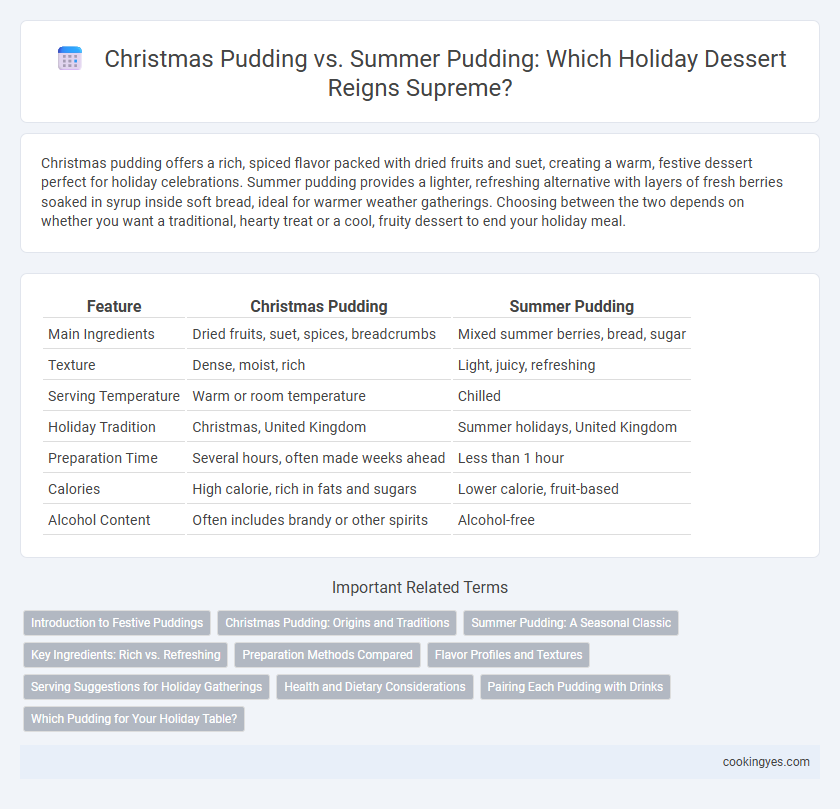Christmas pudding offers a rich, spiced flavor packed with dried fruits and suet, creating a warm, festive dessert perfect for holiday celebrations. Summer pudding provides a lighter, refreshing alternative with layers of fresh berries soaked in syrup inside soft bread, ideal for warmer weather gatherings. Choosing between the two depends on whether you want a traditional, hearty treat or a cool, fruity dessert to end your holiday meal.
Table of Comparison
| Feature | Christmas Pudding | Summer Pudding |
|---|---|---|
| Main Ingredients | Dried fruits, suet, spices, breadcrumbs | Mixed summer berries, bread, sugar |
| Texture | Dense, moist, rich | Light, juicy, refreshing |
| Serving Temperature | Warm or room temperature | Chilled |
| Holiday Tradition | Christmas, United Kingdom | Summer holidays, United Kingdom |
| Preparation Time | Several hours, often made weeks ahead | Less than 1 hour |
| Calories | High calorie, rich in fats and sugars | Lower calorie, fruit-based |
| Alcohol Content | Often includes brandy or other spirits | Alcohol-free |
Introduction to Festive Puddings
Christmas pudding, a traditional British dessert rich with dried fruits, spices, and treacle, is steamed and often soaked in brandy for a warm, rich finish. Summer pudding offers a lighter alternative, layering fresh berries and fruit juices within soft bread to create a refreshing, chilled dessert perfect for warmer holiday gatherings. Both festive puddings showcase seasonal ingredients and cultural heritage, making them iconic choices for holiday celebrations.
Christmas Pudding: Origins and Traditions
Christmas pudding, a rich and dense dessert, originated in medieval England as a savory porridge called "frumenty" before evolving into the steamed suet pudding known today. Traditionally made with dried fruits, spices, and brandy, it is often aged for weeks to deepen its flavor and ceremoniously doused in brandy and set alight when served. The pudding symbolizes prosperity and good luck, a cherished centerpiece in British holiday celebrations steeped in Victorian customs and festive rituals.
Summer Pudding: A Seasonal Classic
Summer pudding, a seasonal classic, showcases ripe summer berries like raspberries, blackberries, and redcurrants soaked in sugar, creating a vibrant, naturally sweet dessert. Unlike the rich, spiced Christmas pudding, summer pudding offers a refreshing, light alternative perfect for warmer holidays. Its layered bread and berry compote provide a visually stunning centerpiece that captures the essence of summer's harvest.
Key Ingredients: Rich vs. Refreshing
Christmas pudding features key ingredients like suet, dried fruits, spices, and molasses, providing a rich, dense texture and deep, warming flavors ideal for winter holidays. Summer pudding relies on fresh, ripe berries, breadcrumbs, and a touch of sugar, creating a light, refreshing dessert perfect for warm weather celebrations. The ingredient contrast highlights the seasonal appeal: hearty and spiced for Christmas versus bright and fruity for summer.
Preparation Methods Compared
Christmas pudding requires a lengthy steaming process lasting several hours, allowing the dense mixture of suet, dried fruits, and spices to develop rich flavors and a moist texture. Summer pudding relies on a no-cook method, where layers of fresh berries and cream-soaked bread are pressed and chilled, preserving the vibrant colors and tangy freshness of seasonal fruits. The contrasting preparation methods highlight the traditional, slow-cooked richness of Christmas pudding versus the light, chilled simplicity of summer pudding.
Flavor Profiles and Textures
Christmas pudding features a rich, dense texture infused with warm spices like cinnamon, nutmeg, and cloves, complemented by dried fruits soaked in brandy for a deep, robust flavor. Summer pudding offers a light, refreshing contrast with a soft, jelly-like texture from soaked bread enveloping fresh summer berries, delivering a naturally sweet and tangy taste. Both desserts highlight seasonal ingredients, but Christmas pudding satisfies with its warming complexity while summer pudding delights with vibrant fruitiness.
Serving Suggestions for Holiday Gatherings
Christmas pudding is traditionally served warm with brandy butter, custard, or cream, making it a rich and festive centerpiece for holiday dinners. Summer pudding, with its vibrant layers of seasonal berries and light sponge, pairs perfectly with chilled clotted cream or vanilla ice cream for a refreshing contrast at warm-weather celebrations. Both desserts offer distinct textures and flavors, ideal for complementing diverse holiday menus and pleasing guests with seasonal fruit or indulgent warmth.
Health and Dietary Considerations
Christmas pudding, rich in dried fruits, suet, and often alcohol, is high in calories and sugar, making it less suitable for those managing diabetes or calorie intake during the holiday season. Summer pudding offers a lighter alternative, composed mainly of fresh berries and bread, providing higher vitamin content and lower fat, beneficial for those seeking a health-conscious dessert. Choosing between the two depends on dietary restrictions, with summer pudding better suited for gluten-free options if adapted with alternative bread.
Pairing Each Pudding with Drinks
Christmas pudding pairs exceptionally well with robust drinks like brandy, mulled wine, or a rich port, enhancing its dense, spiced flavors. Summer pudding, with its lighter, fruity profile made from fresh berries, complements chilled dessert wines or sparkling rose, balancing sweetness with refreshing acidity. Selecting the right drink accentuates the unique textures and tastes, making each pudding a perfect festive treat.
Which Pudding for Your Holiday Table?
Christmas pudding, rich with dried fruits, spices, and often brandy, offers a warm, traditional option perfect for winter holiday tables, while summer pudding features fresh summer berries encased in bread, providing a lighter, refreshing dessert ideal for warmer celebrations. Choosing between these iconic puddings depends on your holiday setting and desired flavor profile; the dense, spiced Christmas pudding complements cozy indoor gatherings, whereas the vibrant, fruity summer pudding suits outdoor or casual events. Both desserts hold cultural significance and bring festive cheer, making them versatile choices for holiday menus across different seasons.
Christmas pudding vs Summer pudding for holiday desserts Infographic

 cookingyes.com
cookingyes.com